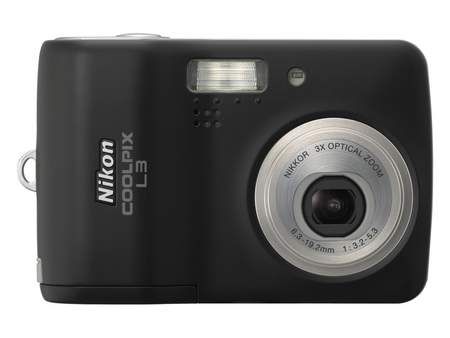Sitting snuggly in the middle of Nikon's three new entry-level cameras, the Coolpix L3 promises a 5.1-megapixel resolution with a smattering of neat subject modes all wrapped in a stylish package.
Our quick take
Given the L3’s price, nice styling and clever ergonomics, it looks great value for money and while it does handle well and look nice, the final image quality lets the side down in the end. Perhaps there is a firmware upgrade in the offing to sort the fringing and highlight loss problems, but either way and on this performance, all I can say is … could do better.

Nikon Coolpix L3 digital camera - 3.5 / 5
| FOR | AGAINST |
|---|---|
|
|
The camera sports the same F3.2-5.3, 38-116mm 3x zoom lens as the superior megapixeled L2 (its got 6 megapixels) but loses out to a faster F2.8-4.9 3x zoom lens on the L4, even though it beats it in megapixel count (it only has 4 megapixels).
Ergonomically the L3 is excellent to use. An uncluttered camera in terms of controls, there’s no mode dial (usually the control mechanism to get into various shooting modes and other options), but just a menu button (more on that in moment), playback button, a rocker-style zoom control and a four way jog control surrounding an OK button, used to confirm menu choices.
These menus provide major camera setting options such as shooting resolution or resolution settings, white balance controls and exposure compensation are here too, so there are no external controls for any shooting features.
A shooting mode button at the base of the camera’s back to the right of the 2-inch colour screen completes the complement and here you can choose between the main point and shoot mode, a Scene mode and finally a movie capture setting. Movies can be recorded at up to 640x680-pixel resolution but at only at a rather jerky 15fps maximum.
The varied scene modes provide a nice package forming the key to controlling the L3 since it lacks manual overrides (even for sensitivity control, which is automatically set between ISO 50 and ISO 200) other than exposure compensation, available via a menu.
Neat tricks include Face Priority AF, where the camera automatically tracks the subject’s face to keep the metering and focus spot on. Similar framing guides appear in Landscape Assist mode and various other modes that have very clever guides to help get a spot on shot such as off centre group shots. Other scene settings include Snow, Fireworks, Night Scene and a Panorama assist setting that overlays previews snaps with the next scene to get a better fit between the shots.
But, there is a problem, one that manifests itself most clearly in the Landscape settings; images are very soft and highlights are totally lost in some contrasty scenes. In addition, colours such as the greens of foliage and almost any reds seem so boosted until they look Disneyesque and very artificial. This is presumably deliberate and set to get a more vibrant looking print at the output stage.
While you can manually pre-set the white balance very easily (which is another neat touch but it is stuck in another menu) tweaking the white balance as closely as I could, colours were still oddly skewed. Finally, there an inordinate amount of blue/purple pixel fringing within any fine detail in high contrast areas, it is some of the worst I’ve seen in my recent camera reviews from any manufacturers. One plus point here however, is the macro performance, which seems very sure-footed by comparison with the other modes.
Recorded images are saved to 23MB of internal memory, which equates to about nine highest quality, highest resolution images or you can save shots using external SD/MMC storage. Power is provided by two AA batteries (you can optimise the camera’s power management for the cells you’ve got on board within menus) that slot under a flap on the base and from which you will get around 200-shots for "normal" alkaline cells, 630 with lithium cells according to Nikon’s testing methods.
To recap
Nikon’s Coolpix L3 is a stylish and well-made compact digital camera that is simple to use and provides more than enough kit for the ‘snaperatti’
